
[thick rule]
matinee today!
for ADULTS only. [all framed by decorative devices]
[thick rule]
BRYAN PATTERSON [framed by decorative devices]
The Man Who Set The Little Calumet River on Fire!
IN
THE MYSTERIOUS
VERMIFAUNA [framed by hands with pointing fingers]
OF KENTA
[triple rule]
Absolutely no refunds after curtain time
[n.p. but probably Gurnee, Ill.: no publisher stated but obviously the Vanishing Press, n.d. but 1968 or 1969]
One of the many advantages of working with Dr. Richardson at the Field Museum was access to his printed wit. Taking the form of lecture announcements, invitations, personalized greetings, and other ephemera, E. Scumas Rory, the nom de plume of Eugene Richardson, and the Vanishing Press would release many “one-offs” to honor visiting scholars, professional acquaintances, and paleontologic or geologic dignitaries. The most delightful of these sort of imprints from the Vanishing Press would be reserved for alumni of the Field Museum, especially its Department of Geology. The announcement for the imaginary lecture on Kenyan vermifauna, by Bryan Patterson (illustrated above), percolates with fact, fiction, barbs, and brickbats.
Bryan Patterson (1909–1979) was one of the most important mammalian paleontologists to emerge from the Field Museum in the twentieth century. Patterson started his paleontologist career at the Field Museum at the age of 17 in 1926, as a fossil preparator under the direction of Elmer S. Riggs (1869–1963). Riggs is best known for demonstrating that Brontosaurus and Apatosaurus were one and the same. Patterson was instrumental in linking vertebrate paleontology classes and research between the Field Museum and the University of Chicago, for which I am quite grateful as a graduate of that three-quarter sequence many years later. Patterson became curator of paleontology in 1937, spending nearly three decades at the Field conducting marvelous field work and research. In 1955, he departed Chicago for Harvard as the Agassiz Professor of Vertebrate Paleontology in the Museum of Comparative Zoology. But he never quite forgot his friends at the Field Museum.
Between 1963 and 1967, Patterson worked with colleagues and students collecting mammals in northern Kenya. In the very first issue of American Association for the Advancement of Science’s weekly journal Science for 1966 appeared a paper by Eugene Richardson, Curator of Fossil Invertebrates at the Field. Entitled “Wormlike fossil from the Pennsylvanian of Illinois,” Richardson described an unusual fossil invertebrate which he named Tullimonstrum gregarium. “While this obscure but plentiful animal is being studied, I prefer not to assign it to a phylum. A great deal of anatomical detail may be deduced from the several hundred specimens on hand, but it must be carefully assessed if the biological relationships are to become clear.” So wrote Richardson about this mysterious organism, on p. 76 of the original Science paper. That paper certainly stimulated Patterson to devise a most convincing tale from Kenya to perplex and confound Tullimonstrum’s taxonomic father.
With the help of several imaginary Kenyan epistolarians — Retired Lieutenant Colonel Cloudesley, Purshottam S. Patel, Joseph N. Ngomo, akai s/o [son of] ckechalon — reports of Tullimonstrum enjoying life in the Ayangyangi Swamp in Turkana, Kenya were constructed by Patterson. The details were so precious that plans were formulated at the Field Museum for an expedition to retrieve this living fossil, an invertebrate rival to the mighty coelacanth.
Bryan Patterson realized that the jig was up. He revealed his handiwork in a memorable 1967 Christmas card:
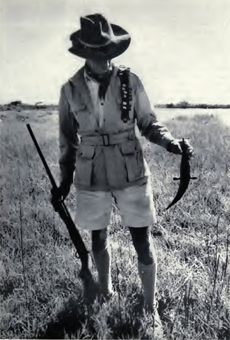
“Though dinosaurs and Dinotheres
May long ago have disappeared,
Despite the volumes now in print
Some creatures just don’t take the hint.
to those who say it cannot be
The Dancing Worm says come and and see,
While in its home with dance and pomp
It rules the vast Ayangyangi Swamp.”
Eugene Richardson’s response to Patterson appeared on several fronts. The Vanishing Press issued a lecture announcement for Bryan Patterson as well as E. Scumas Rory’s Dancing worm of Turkana, both published in 1969. I had the good fortune to work on the Dancing worm briefly, with misprinted scraps as evidence of my efforts as the printer’s apprentice, or to use the proper terminology, the printer’s devil.
I found the lecture announcement for Bryan Patterson to be quite well done, because in part it mentioned my local geography, the Little Calumet River which meandered among factories, parks, and neighborhoods on the south side of Chicago and its southern suburbs. I was quite well acquainted with its polluted surface. For the historically challenged, the news of June 1969 described the terrible fate of the Cuyahoga River in Cleveland, whose polluted contents caused a fire eventually damaging several railroad bridges. The Little Calumet was not to be outdone by the Cuyahoga. Hence, Bryan Patterson was mentioned in the lecture poster as the Little Calumet pyromaniac.
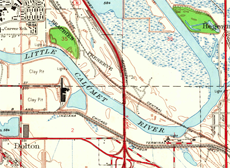
As reward for good behavior as the printer’s devil, the Vanishing Press created several “one-offs” honoring me. In the summer of 1969, I worked with Dr. Richardson as a Shinner Scholar in the Department of Geology at the Field Museum. I spent my waking hours during the day working in the invertebrate fossil collection at the Museum. On evenings and weekends, I would walk from my tiny apartment in Hyde Park to the fourth floor of 5640 South Ellis Avenue, the laboratories of Robert N. Clayton in the Enrico Fermi Institute of the University of Chicago. I was curious about the stable carbon and oxygen isotopes in some very well preserved mollusks from the late Cretaceous (Maastrichtian) Coon Creek Formation, which I had excavated from Coon Creek in McNairy County, Tennessee. My late and odd hours in my sole summer as a scientist led Dr. Richardson to wonder if I ever slept. Hence, he created a greeting card for me on the Vanishing Press, featuring an old image of a bat (retrieved from some Museum print shop archive), quite well known as a nocturnal mammal.
Ed [red]
Valauskas [red]
[ornate frame surrounding image of bat]
brings [red]
you [red]
greetings [red]
[n.p. but probably Gurnee, Ill.: no publisher stated, but obviously the Vanishing Press, n.d. but 1969]
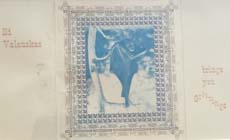
Dr. Clayton’s lab was quite an exciting place in the summer of 1969, for it was one of the few facilities appointed by NASA to analyze the first lunar samples brought back to Earth by Apollo 11. The atmosphere was quite electric, in a high state of preparation for the arrival of those most exotic rocks. My fossil carbonate was tolerated in part because it hearkened back to the origins of the laboratory under the direction of Harold Urey (1893–1981) and his efforts to understand the massive Cretaceous extinction event, using stable isotopes. Dr. Urey and Heinz Lowenstam (1912–1993) actually collected Cretaceous mollusks at Coon Creek two decades earlier in 1949! A Nobel Prize winning fossil collector, such a wonderful thought, with my original guide to the Silurian outcrops in the Chicago area.
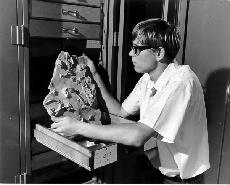
I must admit that all my excited talk to Dr. Richardson about the arrival of lunar samples at the Fermi Institute was incurable and excessive. The best cleansing for my sheer lunacy was a lecture announcement — combining my preoccupations with the Earth’s satellite and paleontology. Given my incessant babble on both fossils and the Moon, I could easily declaim daily, as the poster correctly noted. But the best touch to this printed delight was the actual location provided for my educational talks, the well known, quite ephemeral, non-existent, completely imaginary “Lithuanian Institute for Moral Improvement.” No address was provided for the Institute, but we all know that it was located, back in that fabled, memorable summer of 1969, on the flaming, burning, disinfecting banks of the thickly polluted Little Calumet River meandering in the ever industrious south side of Chicago.
EDW. VALAUSKAS, ESQ.
[woodcut of lunar surface]
OFFERS A HIGHLY EDUCATIONAL
Lecture
ON
Lunar Paleontology
daily at 3 P M
LITHUANIAN INSTITUTE FOR MORAL IMPROVEMENT
[n.p. but probably Gurnee, Ill.: no publisher stated but obviously the Vanishing Press, n.d. but 1969]
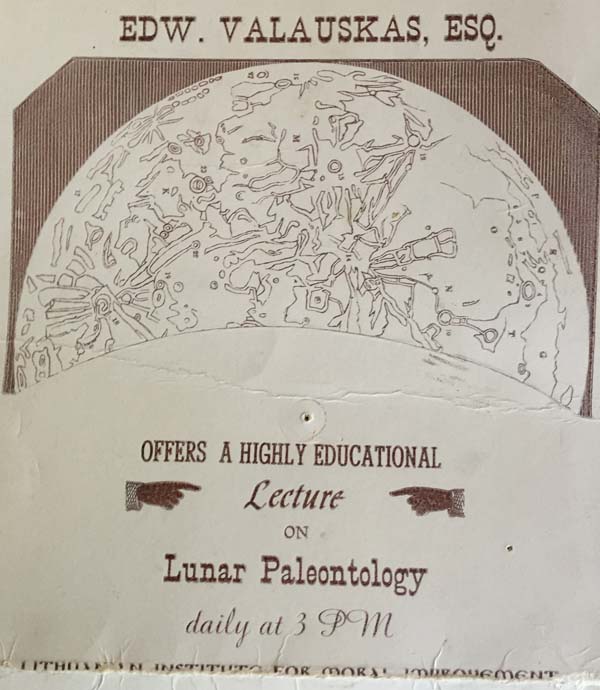
Last corrected 23 August 2016. | © 2016 Greenwood Road Books. All rights reserved. | Questions? Send e–mail to books [at] greenwoodroadbooks [dot] com